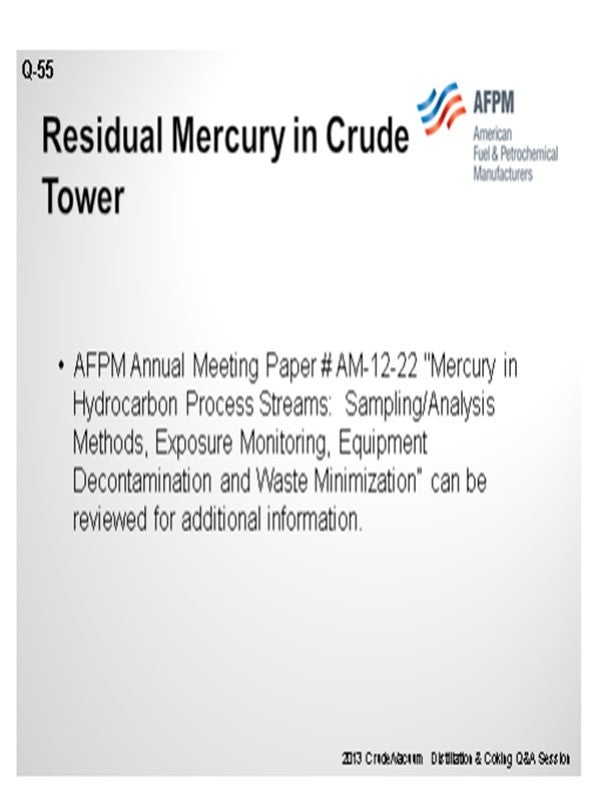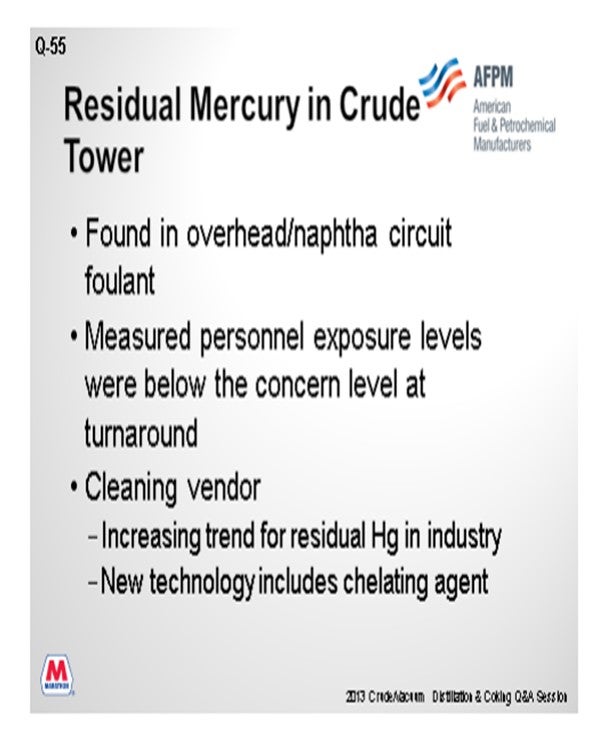Question 55: In a recent turnaround, we successfully de-gassed and de-greased our crude tower but discovered residual mercury. What techniques have been used to mitigate this issue?
SHENKLE (Flint Hills Resources, Ltd.)
We recommend pre-turnaround development of a PPE matrix that can be used during the turnaround which outlines the PPE required should you discover mercury during the outage. We would remove residual material with vacuums rated for the service and then tunnel the tower, wearing the proper PPE, to survey for mercury. We also recommend, as a good practice, to increase air exchanges when possible. For hot work, we require breathing air in full suits. I encourage you to reference AFPM Annual Meeting Paper #AM12-22 for further information on mercury management during a turnaround.

HERLEVICH (Marathon Petroleum Corporation)
During the online run, not during turnaround, we found mercury in some of the foulants in the overhead and in the naphtha circuits. We have observed this material while blowing down sight glasses or working on a pump or exchangers, so we have become very mindful of the potential for exposure during the turnaround. During the actual turnaround, our Industrial Hygiene personnel conducted monitoring for mercury and found exposure levels well below the concern level. One of our chemical vendors indicated a marked increase in the trend of finding mercury during turnarounds, so that is a very good question. At least one of the vendors has a new technology that includes a chelating agent which lets you remove the mercury from the wastewater collected in the temporary tanks. This was a very novel approach. I do not think that this technology is commercial yet, but I believe it is in the development process.

UNIDENTIFIED SPEAKER (Shell Global Solutions U.S.)
Have you considered trying to detect or monitor the presence of mercury in crudes in the first place and stopping it there by getting back to your traders or purchaser and putting specifications in your purchasing contracts?
SHENKLE (Flint Hills Resources, Ltd.)
We have done sampling for particular crudes to try and identify sources, but I am not aware of any specific having been include in a contract.
RUSSELL “RUSTY” STRONG (Athlon Solutions)
The mercury in crude oil has been a problem for many years now. It seems to pop up sporadically. The first time I saw it at least about 20 years ago, it was attributed to oils coming out of Alaska down the pipeline. Certainly the Indonesian gas wells are laden with mercury, and any of the crude oils that come from that same area can also be contaminated. The question I have is: When mercury has been seen in a refinery, has there been an effort to look at the record of crude oils processed to get a general idea of possible sources of mercury? If so, a common sharing of that information could be a heads-up for future operations, as well to other operators, at least until such time as mercury determination in the crude can simply be determined by the refinery lab during operation.
HERLEVICH (Marathon Petroleum Corporation)
We have not done any monitoring. We know it is present in the crudes, and we are mindful of this when we do work.
SHENKLE (Flint Hills Resources, Ltd.)
So as suggested, I encourage you to read Annual Paper #AM12-22. In this paper, there is some discussion about mass balances and estimations around mercury deposition.
BOB SHENKLE (Flint Hills Resources, LP)
At FHR, we put together a PPE matrix pre-turnaround to tell us the type of PPE required to execute the scope of work if mercury is present. We then remove residual material (potentially containing mercury) using vacuums designed for the application. Then, wearing the proper PPE, we tunnel the tower and take readings for mercury. Increasing air exchanges, when possible, is a good practice to follow. All hot work requires fresh air and full suits. Non-welding work would be assessed and PPE defined accordingly. AFPM Annual Meeting Paper #AM-12-22 “Mercury in Hydrocarbon Process Streams: Sampling/Analysis Methods, Exposure Monitoring, Equipment Decontamination, and Waste Minimization” – by Brad Hase, FHR Global Turnaround Manager; Ron Radford, PEI Business Development Manager; and, Vic Vickery, PEI Technical Manager – can be reviewed for additional information.